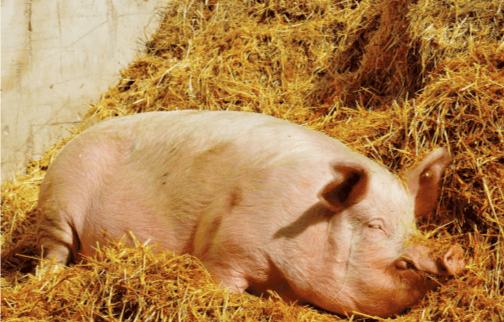Freedom from Discomfort
The Freedom from Discomfort! This freedom is all about ensuring we provide domestic animals comfort which is achieved in different ways.
At the end of a long day, where do you want to lay down and rest? Probably kicking up your feet on a comfy chair or couch or maybe going for a snooze in your bed. You probably wouldn’t pick a cold cement floor for relaxing! That would be uncomfortable and not a great place for a rest! Just like humans, animals also experience discomfort if they are not provided with a comfortable resting area. Being uncomfortable much of the time affects the health and happiness of an animal, so it is important that we provide animals with a comfortable resting area whenever possible.

Background Information to Share with Students
What is comfy?
What is considered to be a comfortable resting area? Well, it depends! Different animal species vary in how they feel comfortable. For example, dogs might be perfectly happy resting on a dog bed on the floor, and cats may prefer to rest on the top level of a cat tree, or even in a box where they feel hidden and safe. Large animals like cows prefer to rest in areas with at least enough space to be able to lie down, turn around, and get back up again. They also like areas that are cushioned, so that its more comfortable and they don’t hurt their knees. Cold blooded animal such as snakes and lizards like the ability to rest under the glow of the sun or a heat lamp. Some animals like rabbits, rats, and hamsters feel most safe resting in hide boxes where they can’t be easily seen.
Overall, there is a wide variety between species on what is comfortable and therefore it is important to do your research to find out what is comfortable for your specific type of animal. In general, however, most animals prefer resting areas that are warm, dry, clean, and quiet.


Escaping the elements
Another important part of this freedom is providing your animal with suitable shelter. Just like humans, animals are also sensitive to the elements. Rain, wind, snow, and extreme heat or cold can make animals very uncomfortable. Therefore, it is important to provide animals with shelter so that they can get away from these elements when necessary. Allowing companion animals such as cats and dogs to live in your home is one way of meeting this freedom. If you live on a farm, and have outdoor dogs and cats they would need a shelter, such as an insulated dog house or access to a garage or barn. For livestock who are commonly kept outdoors such as cows, goats, and horses, it is necessary to ensure they have access to shelter to escape the elements.
Other ways to feel uncomfortable
This freedom also involves making sure you are grooming your animals and providing them with good hygiene. For some species, if you don’t groom them properly they can develop health conditions that cause them to feel uncomfortable. For example, horses need to be brushed regularly to remove dead hair and skin, otherwise they can develop painful skin conditions. In addition, they need to have their hooves trimmed often. If a horse’s hooves are too long, the horse can have trouble walking and they may become injured as a result. Other animals also need to be groomed regularly. For instance, long-haired dogs often need to visit the groomer to get their fur trimmed, and cats require brushing. Otherwise, their fur can easily become matted which can be painful or cause other skin issues. If you are unsure how often you should be grooming your animal, check in with your veterinarian.
It is our duty as responsible pet owners to ensure that our pets are comfortable in the living conditions we have provided them with.

Discussion Questions:
- Do you have an animal, or know of someone who does? Where does the animal prefer to rest? Do you notice differences in resting places between species? Why do you think this is?
- What is an animal seems to prefer an uncomfortable resting area (i.e.: some dogs like to lay on the floor even though they have a bed)?
- As long as they have the option to rest some place more comfortable, it is ok if they like to rest in areas that seem uncomfortable to us. Dogs may choose to lay on the floor because it is cooler than their bed.
- Sometimes animals don’t like to be brushed or groomed. What can animal caretakers do to make being brushed less stressful or many enjoyable?
- Reward good/calm behaviour, speak quietly, give lots of praise, handle the animal gently, make grooming a positive experience.
Activities:
1. Finish the Picture
Print off pictures of different domestic animals, cut them out and place them on a white piece of paper. Have students draw in the background with what would be a comfortable resting area for the animals.
2. Research
Have students pick an animal (pet or farm) and research how to provide for the freedom of discomfort (shelter, grooming, hygiene).
3. Class Action
Contact your local shelter or rescue group and ask what they need to help animals in their care feel more comfortable. As a class, collect or make some of the items on their wish list.


